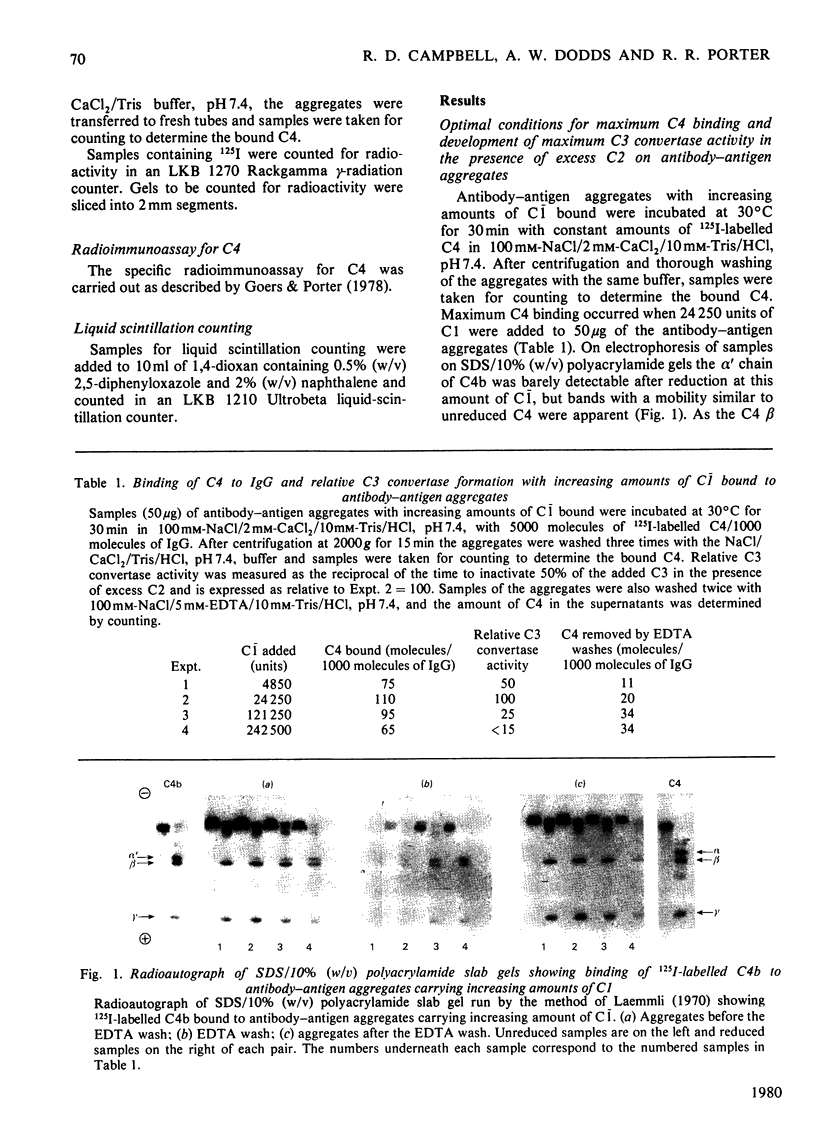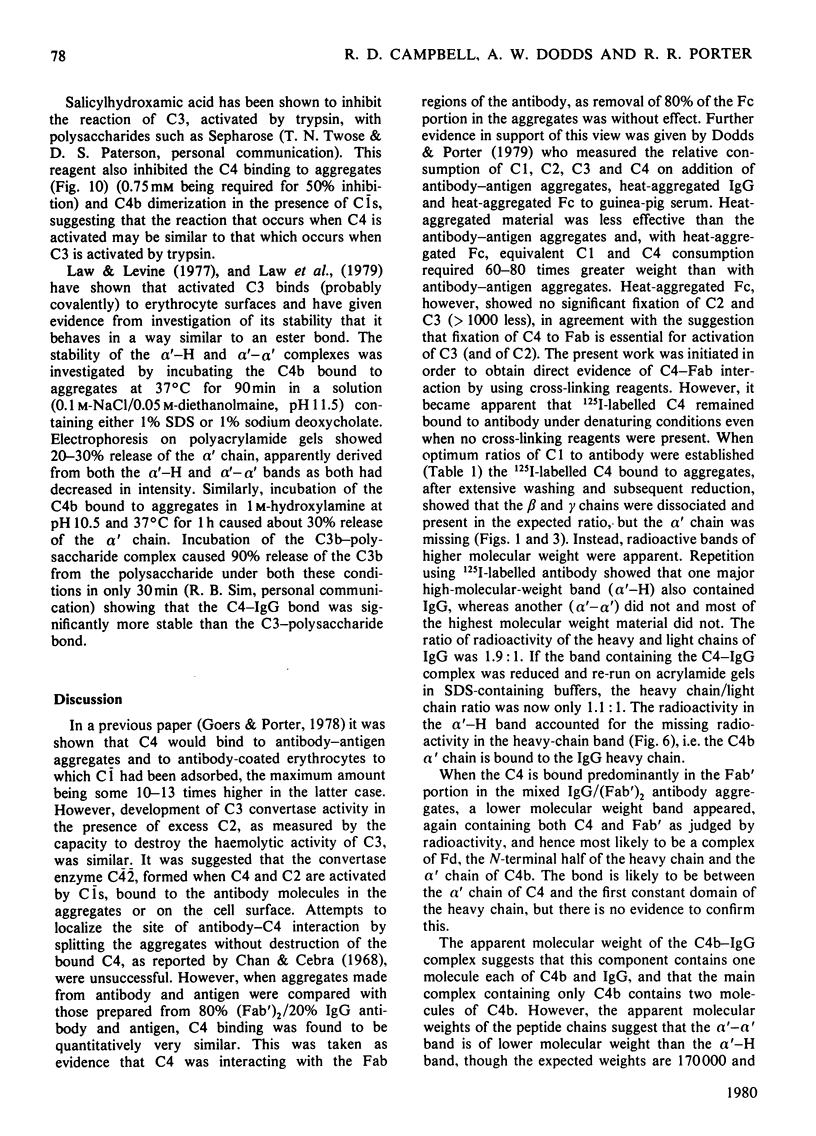Abstract
The binding of human complement component C4 to antibody-antigen aggregates and the nature of the interaction have been investigated. When antibody-antigen aggregates with optimal C1 bound are incubated with C4, the C4 is rapidly cleaved to C4b, but only a small fraction (1-2%) is bound to the aggregates, the rest remaining in the fluid phase as inactive C4b. It has been found that C4b and th antibody form a very stable complex, due probably to the formation of a covalent bond. On reduction of the C4b-immunoglobulin G (IgG) complex, the beta and gamma chains, but not the alpha' chain, of C4b are released together with all the light chain, but only about half of the heavy chain of IgG. The reduced aggregates contain two main higher-molecular-weight complexes, one shown by the use of radioactive components to contain both IgG and C4b and probably therefore the alpha' chain of C4b and the heavy chain of IgG, and the other only C4b and probably an alpha' chain dimer. The aggregates with bound C1 and C4b show maximal C3 convertase activity, in the presence of excess C2, when the alpha'-H chain component is in relatively highest amounts. When C4 is incubated with C1s in the absence of aggregates, up to 15% of a C4b dimer is formed, which on reduction gives an alpha' chain complex, probably a dimer. The apparent covalent interaction between C4b and IgG and between C4b and other C4b molecules cannot be inhibited by iodoacetamide and hence cannot be catalysed by transglutaminase (factor XIII). The reaction is, however, inhibited by cadaverine and putrescine and 14C-labelled putrescine is incorporated into C4, again by a strong, probably covalent, bond. It is suggested that a reactive group, possibly an acyl group, is generated when C4 is activated by C1 and that this reactive group can react with IgG, with another C4 molecule, or with water.
Full text
PDF













Images in this article
Selected References
These references are in PubMed. This may not be the complete list of references from this article.
- Arlaud G. J., Sim R. B., Duplaa A. M., Colomb M. G. Differential elution of Clq, Clr and Cls from human Cl bound to immune aggregates. Use in the rapid purification of Cl subcomponents. Mol Immunol. 1979 Jul;16(7):445–450. doi: 10.1016/0161-5890(79)90069-5. [DOI] [PubMed] [Google Scholar]
- Baker J. B., Simmer R. L., Glenn K. C., Cunningham D. D. Thrombin and epidermal growth factor become linked to cell surface receptors during mitogenic stimulation. Nature. 1979 Apr 19;278(5706):743–745. doi: 10.1038/278743a0. [DOI] [PubMed] [Google Scholar]
- Borsos T., Rapp H. J. Immune hemolysis: a simplified method for the preparation of EAC'4 with guinea pig or with human complement. J Immunol. 1967 Aug;99(2):263–268. [PubMed] [Google Scholar]
- Byrt P., Ada G. L. An in vitro reaction between labelled flagellin or haemocyanin and lymphocyte-like cells from normal animals. Immunology. 1969 Oct;17(4):503–516. [PMC free article] [PubMed] [Google Scholar]
- Carpenter F. H., Harrington K. T. Intermolecular cross-linking of monomeric proteins and cross-linking of oligomeric proteins as a probe of quaternary structure. Application to leucine aminopeptidase (bovine lens). J Biol Chem. 1972 Sep 10;247(17):5580–5586. [PubMed] [Google Scholar]
- Chan P. C., Cebra J. J. Structural studies of products of antigen-antibody-complement interaction. Immunochemistry. 1968 Jan;5(1):1–8. doi: 10.1016/0019-2791(68)90219-x. [DOI] [PubMed] [Google Scholar]
- Chung S. I., Lewis M. S., Folk J. E. Relationships of the catalytic properties of human plasma and platelet transglutaminases (activated blood coagulation factor XIII) to their subunit structures. J Biol Chem. 1974 Feb 10;249(3):940–950. [PubMed] [Google Scholar]
- Cooper N. R., Müller-Eberhard H. J. A comparison of methods for the molecular quantitation of the fourth component of human complement. Immunochemistry. 1968 Mar;5(2):155–169. doi: 10.1016/0019-2791(68)90100-6. [DOI] [PubMed] [Google Scholar]
- Cooper N. R., Müller-Eberhard H. J. The reaction mechanism of human C5 in immune hemolysis. J Exp Med. 1970 Oct 1;132(4):775–793. doi: 10.1084/jem.132.4.775. [DOI] [PMC free article] [PubMed] [Google Scholar]
- Curtis C. G., Stenberg P., Chou C. H., Gray A., Brown K. L., Lorand L. Titration and subunit localization of active center cysteine in fibrinoligase (thrombin-activated fibrin stabilizing fector). Biochem Biophys Res Commun. 1973 May 1;52(1):51–56. doi: 10.1016/0006-291x(73)90952-2. [DOI] [PubMed] [Google Scholar]
- Dodds A. W., Porter R. R. The activation of complement components by aggregates of antibodies and their fragments. Mol Immunol. 1979 Dec;16(12):1059–1062. doi: 10.1016/0161-5890(79)90039-7. [DOI] [PubMed] [Google Scholar]
- Dodds A. W., Sim R. B., Porter R. R., Kerr M. A. Activation of the first component of human complement (C1) by antibody-antigen aggregates. Biochem J. 1978 Nov 1;175(2):383–390. doi: 10.1042/bj1750383. [DOI] [PMC free article] [PubMed] [Google Scholar]
- Fanger M. W., Hart D. A., Wells J. V., Nisonoff A. Requirement for cross-linkage in the stimulation of transformation of rabbit peripheral lymphocytes by antiglobulin reagents. J Immunol. 1970 Dec;105(6):1484–1492. [PubMed] [Google Scholar]
- Folk J. E., Finlayson J. S. The epsilon-(gamma-glutamyl)lysine crosslink and the catalytic role of transglutaminases. Adv Protein Chem. 1977;31:1–133. doi: 10.1016/s0065-3233(08)60217-x. [DOI] [PubMed] [Google Scholar]
- Gigli I., Porter R. R., Sim R. B. The unactivated form of the first component of human complement, C1. Biochem J. 1976 Sep 1;157(3):541–548. doi: 10.1042/bj1570541. [DOI] [PMC free article] [PubMed] [Google Scholar]
- Gigli I., von Zabern I., Porter R. R. The isolation and structure of C4, the fourth component of human complement. Biochem J. 1977 Sep 1;165(3):439–446. doi: 10.1042/bj1650439. [DOI] [PMC free article] [PubMed] [Google Scholar]
- Goers J. W., Porter R. R. The assembly of early components of complement on antibody-antigen aggregates and on antibody-coated erythrocytes. Biochem J. 1978 Nov 1;175(2):675–684. doi: 10.1042/bj1750675. [DOI] [PMC free article] [PubMed] [Google Scholar]
- Goldlust M. B., Shin H. S., Hammer C. H., Mayer M. M. Studies of complement complex C5b,6 eluted from--EAC-6: reaction of C5b,6 with EAC4b,3b and evidence on the role of C2a and C3b in the activation of C5. J Immunol. 1974 Sep;113(3):998–1007. [PubMed] [Google Scholar]
- Gordon J., Whitehead H. R., Wormall A. The Action of Ammonia on Complement. The Fourth Component. Biochem J. 1926;20(5):1028–1035. doi: 10.1042/bj0201028. [DOI] [PMC free article] [PubMed] [Google Scholar]
- Kerr M. A. Limited proteolysis of complement components C2 and factor B. Structural analogy and limited sequence homology. Biochem J. 1979 Dec 1;183(3):615–622. doi: 10.1042/bj1830615. [DOI] [PMC free article] [PubMed] [Google Scholar]
- Kerr M. A., Porter R. R. The purification and properties of the second component of human complement. Biochem J. 1978 Apr 1;171(1):99–107. doi: 10.1042/bj1710099. [DOI] [PMC free article] [PubMed] [Google Scholar]
- Laemmli U. K. Cleavage of structural proteins during the assembly of the head of bacteriophage T4. Nature. 1970 Aug 15;227(5259):680–685. doi: 10.1038/227680a0. [DOI] [PubMed] [Google Scholar]
- Law S. K., Levine R. P. Interaction between the third complement protein and cell surface macromolecules. Proc Natl Acad Sci U S A. 1977 Jul;74(7):2701–2705. doi: 10.1073/pnas.74.7.2701. [DOI] [PMC free article] [PubMed] [Google Scholar]
- Law S. K., Lichtenberg N. A., Levine R. P. Evidence for an ester linkage between the labile binding site of C3b and receptive surfaces. J Immunol. 1979 Sep;123(3):1388–1394. [PubMed] [Google Scholar]
- Linsley P. S., Blifeld C., Wrann M., Fox C. F. Direct linkage of epidermal growth factor to its receptor. Nature. 1979 Apr 19;278(5706):745–748. doi: 10.1038/278745a0. [DOI] [PubMed] [Google Scholar]
- Lumsden J., Coggins J. R. The subunit structure of the arom multienzyme complex of Neurospora crassa. A possible pentafunctional polypeptide chain. Biochem J. 1977 Mar 1;161(3):599–607. doi: 10.1042/bj1610599. [DOI] [PMC free article] [PubMed] [Google Scholar]
- MUELLER-EBERHARD H. J., BIRO C. E. ISOLATION AND DESCRIPTION OF THE FOURTH COMPONENT OF HUMAN COMPLEMENT. J Exp Med. 1963 Sep 1;118:447–466. doi: 10.1084/jem.118.3.447. [DOI] [PMC free article] [PubMed] [Google Scholar]
- MUELLER-EBERHARD H. J., LEPOW I. H. C'1 ESTERASE EFFECT ON ACTIVITY AND PHYSICOCHEMICAL PROPERTIES OF THE FOURTH COMPONENT OF COMPLEMENT. J Exp Med. 1965 May 1;121:819–833. doi: 10.1084/jem.121.5.819. [DOI] [PMC free article] [PubMed] [Google Scholar]
- Müller-Eberhard H. J., Polley M. J., Calcott M. A. Formation and functional significance of a molecular complex derived from the second and the fourth component of human complement. J Exp Med. 1967 Feb 1;125(2):359–380. doi: 10.1084/jem.125.2.359. [DOI] [PMC free article] [PubMed] [Google Scholar]
- Nelson R. A., Jr, Jensen J., Gigli I., Tamura N. Methods for the separation, purification and measurement of nine components of hemolytic complement in guinea-pig serum. Immunochemistry. 1966 Mar;3(2):111–135. doi: 10.1016/0019-2791(66)90292-8. [DOI] [PubMed] [Google Scholar]
- Polley M. J., Müller-Eberhard H. J. The second component of human complement: its isolation, fragmentation by C'1 esterase, and incorporation into C'3 convertase. J Exp Med. 1968 Sep 1;128(3):533–551. doi: 10.1084/jem.128.3.533. [DOI] [PMC free article] [PubMed] [Google Scholar]
- Porter R. R., Reid K. B. The biochemistry of complement. Nature. 1978 Oct 26;275(5682):699–704. doi: 10.1038/275699a0. [DOI] [PubMed] [Google Scholar]
- Reboul A., Thielens N., Villiers M. B., Colomb M. G. Purification of human complement subcomponent C4. C4 cleavage by C1s. FEBS Lett. 1979 Jul 1;103(1):156–161. doi: 10.1016/0014-5793(79)81271-5. [DOI] [PubMed] [Google Scholar]
- Reid K. B. A collagen-like amino acid sequence in a polypeptide chain of human C1q (a subcomponent of the first component of complement). Biochem J. 1974 Jul;141(1):189–203. doi: 10.1042/bj1410189. [DOI] [PMC free article] [PubMed] [Google Scholar]
- Steinbuch M., Pejaudier L., Quentin M., Martin V. Molecular alteration of alpha-2-macroglobulin by aliphatic amines. Biochim Biophys Acta. 1968 Jan 22;154(1):228–231. doi: 10.1016/0005-2795(68)90277-8. [DOI] [PubMed] [Google Scholar]
- Swenson R. P., Howard J. B. Characterization of alkylamine-sensitive site in alpha 2-macroglobulin. Proc Natl Acad Sci U S A. 1979 Sep;76(9):4313–4316. doi: 10.1073/pnas.76.9.4313. [DOI] [PMC free article] [PubMed] [Google Scholar]
- Tack B. D., Prahl J. W. Third component of human complement: purification from plasma and physicochemical characterization. Biochemistry. 1976 Oct 5;15(20):4513–4521. doi: 10.1021/bi00665a028. [DOI] [PubMed] [Google Scholar]
- Wilkinson J. M. Variation in the N-terminal sequence of heavy chains of immunoglobulin G from rabbits of different allotype. Biochem J. 1969 Apr;112(2):173–185. doi: 10.1042/bj1120173. [DOI] [PMC free article] [PubMed] [Google Scholar]





